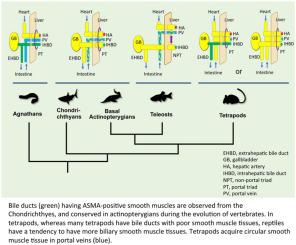Annals of Anatomy ( IF 2.2 ) Pub Date : 2020-09-07 , DOI: 10.1016/j.aanat.2020.151594 Noriaki Ota 1 , Haruka Hirose 2 , Hideaki Kato 3 , Hikari Maeda 4 , Nobuyoshi Shiojiri 2

|
Background
The liver architecture of vertebrates can be classified into two types, the portal triad type (having periportal bile ducts) and the non-portal triad type (having non-periportal bile ducts). The former is detectable from the hagfish, which is the most ancestral vertebrate, to tetrapod livers whereas many actinopterygian livers have the latter. The aim of the present study is to reveal the distribution of smooth muscle tissue in livers of various vertebrates with attention to their architectures.
Methods
Smooth muscle was immunohistochemically compared in hepatic blood vessels and bile ducts of various vertebrates, using an anti-alpha-smooth muscle actin (ASMA) antibody.
Results
Smooth muscle was noted in the gallbladder and hepatic artery in all vertebrates, including the hagfish. Bile ducts having ASMA-positive smooth muscles were absent in the hagfish, but detected in the Chondrichthyes and conserved in actinopterygians with or without portal triads during the evolution of vertebrates. In tetrapods having portal triads, reptiles had a tendency to have strongly ASMA-positive biliary smooth muscle tissues whereas other tetrapods had bile ducts with poor smooth muscle tissues. Although the hagfish liversnever had ASMA-positive smooth muscle tissue in the walls of portal and central veins, it was observed in discontinuous distributions or not observed in portal veins and central veins of chondrichthyans and actinopterygians. By contrast, in most tetrapods, ASMA-positive smooth muscle tissue was detectable in portal veins, which supported the adjacent endothelial cells as a circular layer. Central veins did not consistently have smooth muscle tissue in these groups.
Discussion and conclusion
The hagfish liver may retain more ancestral characteristics than other vertebrates in terms of smooth muscle distribution in the vascular and biliary systems. Actinopterygians might have a different mechanism of bile transport from tetrapods from their smooth muscle distribution in intrahepatic bile ducts. The circular smooth muscle distribution in portal veins might be a characteristic acquired by tetrapods.
中文翻译:

各种脊椎动物肝脏中平滑肌组织分布的免疫组织学分析,注意它们的不同结构。
背景
脊椎动物的肝脏结构可分为两种类型,门脉三联体型(具有门脉周围胆管)和非门脉三联体型(具有非门脉周围胆管)。前者可以从盲鳗(最古老的脊椎动物)到四足动物的肝脏中检测到,而许多放线鱼类的肝脏则具有后者。本研究的目的是揭示各种脊椎动物肝脏中平滑肌组织的分布,并关注它们的结构。
方法
使用抗α-平滑肌肌动蛋白 (ASMA) 抗体对各种脊椎动物的肝血管和胆管中的平滑肌进行免疫组织化学比较。
结果
在包括盲鳗在内的所有脊椎动物的胆囊和肝动脉中都发现了平滑肌。在盲鳗中不存在具有 ASMA 阳性平滑肌的胆管,但在软骨鱼类中检测到,并且在脊椎动物进化过程中在有或没有门静脉三联体的放线鱼中保守。在具有门静脉三联体的四足动物中,爬行动物倾向于具有强烈的 ASMA 阳性胆道平滑肌组织,而其他四足动物的胆管具有平滑肌组织较差的胆管。虽然盲鳗的肝脏在门静脉和中央静脉壁中没有 ASMA 阳性平滑肌组织,但在软骨鱼类和放线鱼类的门静脉和中央静脉中观察到不连续分布或未观察到。相比之下,在大多数四足动物中,在门静脉中可检测到 ASMA 阳性平滑肌组织,将相邻的内皮细胞支撑为圆形层。在这些组中,中央静脉并不始终具有平滑肌组织。
讨论与结论
就血管和胆道系统中的平滑肌分布而言,盲鳗肝脏可能比其他脊椎动物保留更多的祖先特征。从四足动物在肝内胆管中的平滑肌分布来看,放线鱼类可能具有不同的胆汁运输机制。门静脉中的圆形平滑肌分布可能是四足动物获得的特征。



























 京公网安备 11010802027423号
京公网安备 11010802027423号